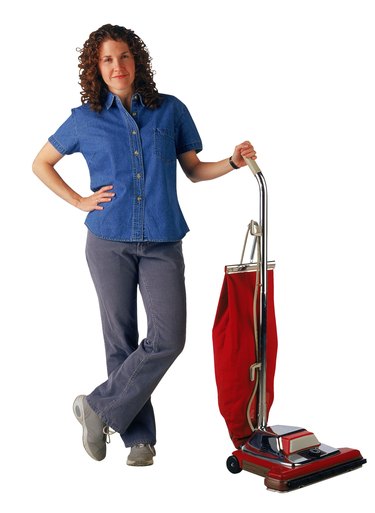
Vacuum cleaners keep our homes tidy and fresh. With age or excessive use, though, a vacuum cleaner motor begins to lose power, causing wear on other parts and weakening the vacuum's cleaning suction. As the motor struggles to perform, it becomes hotter and hotter, eventually overheating. The result is a strange and unpleasant odor and a vacuum cleaner that refuses to power up and work again. Most times this result is only temporary; there are steps you can take to repair the problem and prevent it from occurring again.
Step 1
Clean out the vacuum canister after each use (even during a cleaning job if you notice the canister is partially filled) or when the bag becomes 75 percent full if your vacuum requires a filter bag. When the canister or filter bag gets too full, the dirt and dust inside overflows and works its way into the inner workings of the vacuum; otherwise it impedes the vacuum from picking up more. Once inside, this debris may clog the vacuum or collect on the motor, both of which can cause the vacuum motor to overheat. Eliminating the source of debris helps get the vacuum running again and prevents future problems.
Video of the Day
Step 2
Check the vacuum for obstructions. Examine all hoses, attachments, and brushes for clumped dirt, hair and debris. Examine the brushes specifically for strings, hairs, threads, carpet piling, even toys that may get caught in the brush and prevent it from rolling properly. These types of clogs and interferences prevent proper airflow within the vacuum, therefore causing overheating. Removing clogs frees airflow and gets the vacuum running again.
Step 3
Check the belt at its position on the roller brush. The motor drives the belt (along with the vacuum suction), which in turn causes the roller brush to spin. Obstructions hindering the brush may lead to a broken belt. Belts also break with age, overuse or simply because they are faulty from the factory. When a belt breaks, the motor may over-rev, since the belt and roller no longer give resistance to the motor. An overworked motor will overheat. Replace a stretched or broken belt to help solve this problem.
Step 4
Look at the air filter. Air filters are located in different places on different vacuums. The air filter's job is to clean the air that flows through the vacuum and pull out any dirt, dust and hair that finds its way in. As with any air filter, a vacuum air filter becomes full, dirty or clogged over time, slowing the rate at which air moves through. When this occurs, the motor works harder to force air through at its normal rate. The motor then overheats. Clean the air filter with a damp cloth to solve this problem. Let it dry completely.
Step 5
Allow the vacuum to cool off. After the maintenance steps have been performed, the main thing is to allow the motor to cool off. A hot motor often does not run properly, and most vacuums have special instruments inside that automatically shut them off when they overheat to prevent serious damage and accidents. Once maintenance is performed and the vacuum cools down, it should run normally once more.
Video of the Day